At my monthly plasma donation this afternoon they went to put blue wrap around my arm just before I was done.
“You don’t have any green wrap do you?”, I asked.
They did. So that’s what I got.
It was a very Green donation otherwise: the man at the bed next to me was sporting a Peter Bevan-Baker button, and my nurse mentioned that he sister lives on the same street as Karla Bernard and has a Green sign-making operation in her garage.
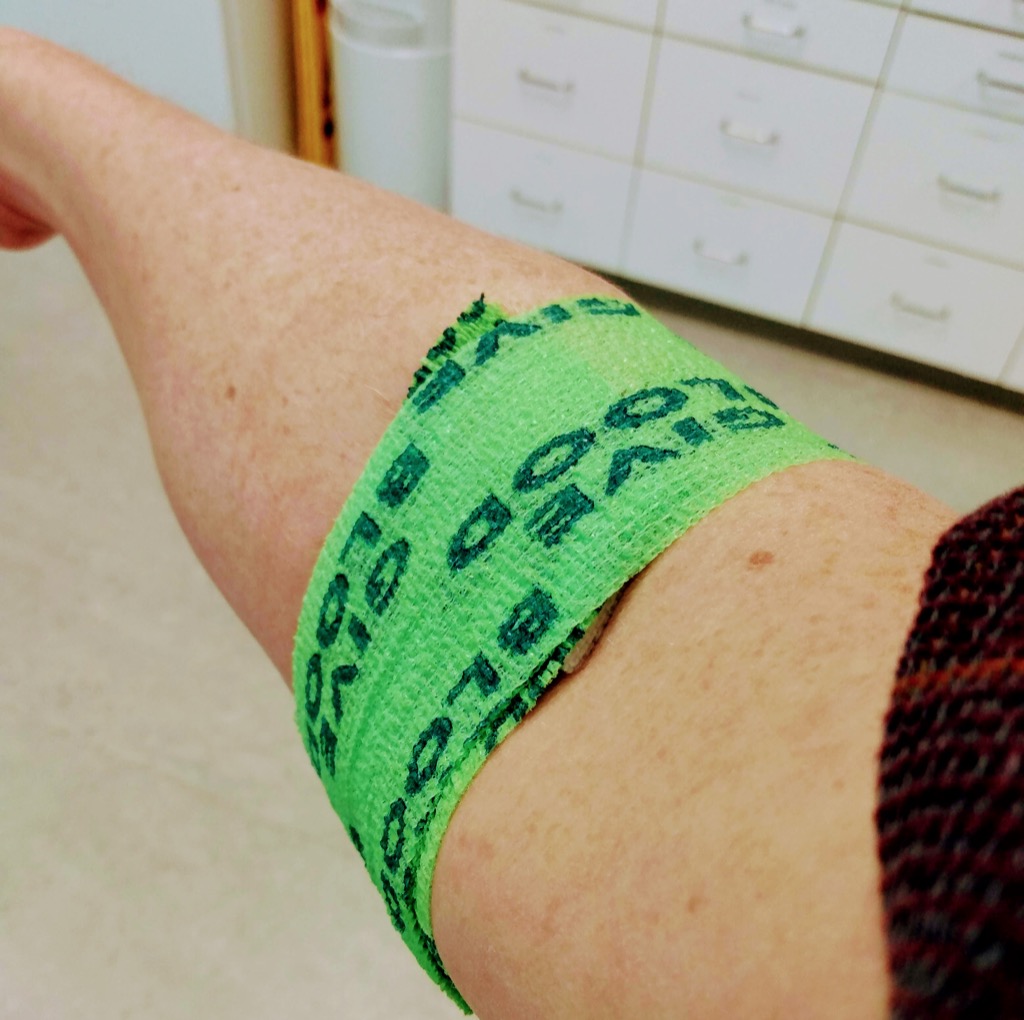
I have been immersed in election geography this week, and by way of procrastinating I made this visualization that connects every address on Prince Edward Island to its polling station on election day.
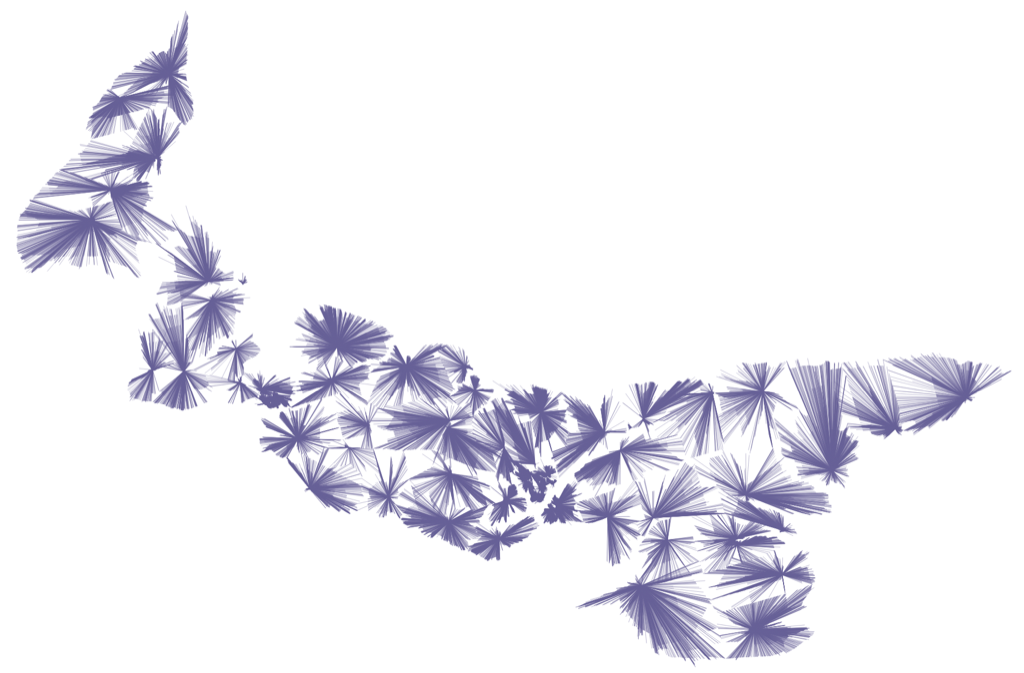
Here’s a similar visualization, but for the advance polls:
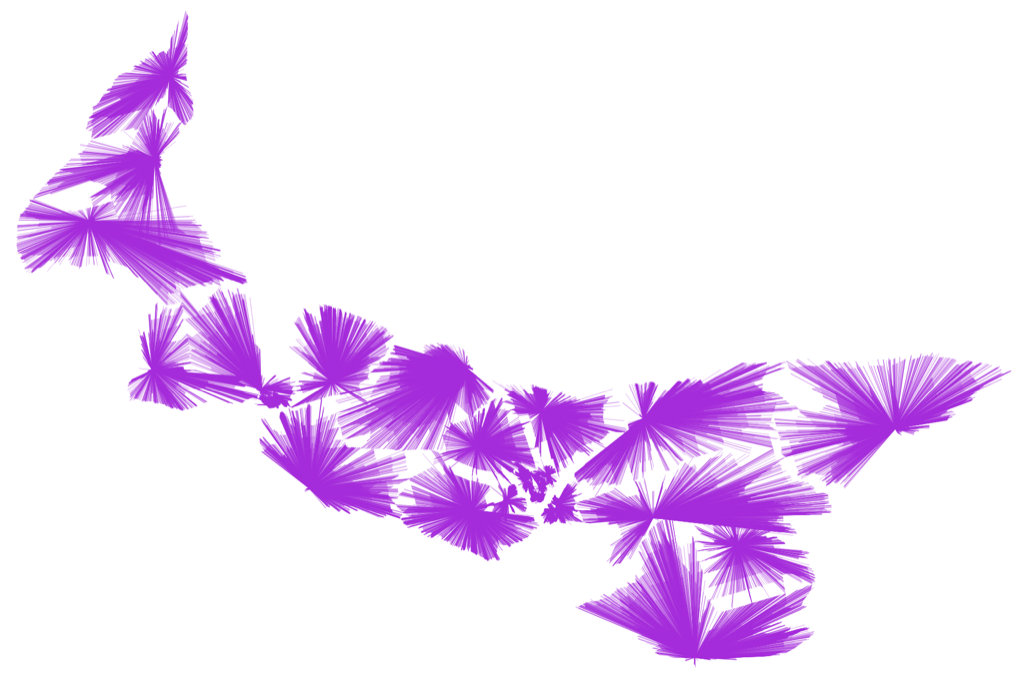
I shared the map with a friend, and they asked me if I could tell them, as the crow flies, which addresses were the greatest distance from their polling station on election day, so I made this map to illustrate this. There’s one dot on the map for each civic address on PEI; the darker the colour of orange of the dot, the greater the distance to the polling station for electors at that address.
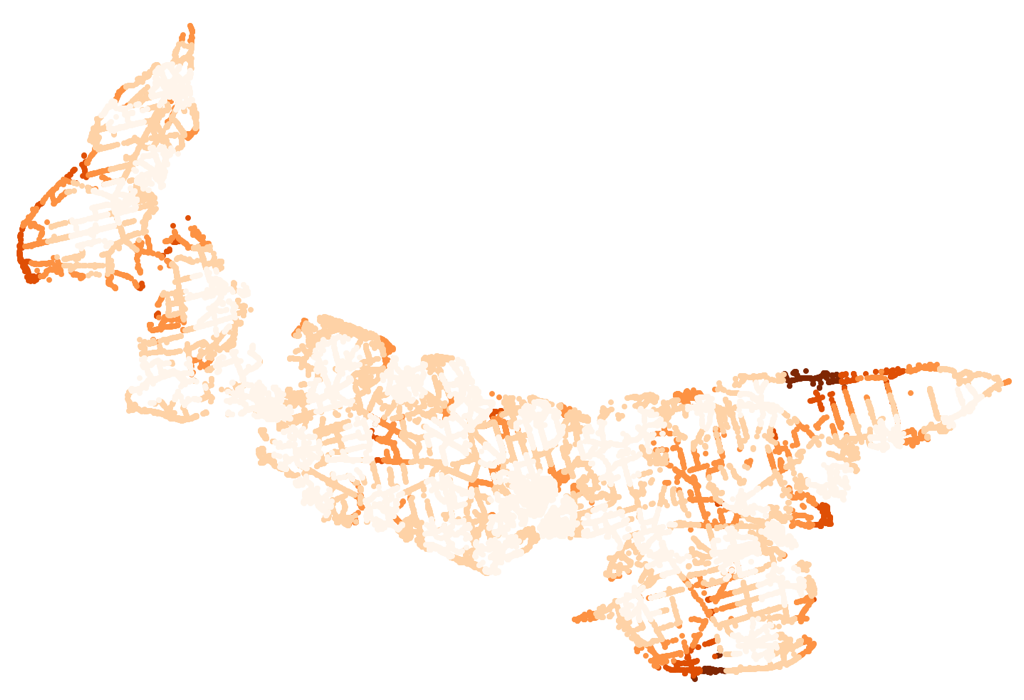
The greatest address-to-poll distances are from Goose River and Little Sands.
There are, it turns out, two places in New England named Salem, one in New Hampshire and one in Massachusetts.
I learned this on Saturday morning when I woke up in the wrong one.
My plan for the day was to attend a book sale at the Museum of Printing in Haverhill, Massachusetts.
On Friday morning when I took a cursory look at a map of New England–Yankee Publishing, as you might imagine, is bursting with maps of New England–I saw that Salem was nearby and thought “oh, that’s interesting, I’ll spend tonight there.”
And so I booked myself a room at the Merchant Salem, a smart looking hotel downtown. On Friday afternoon I dutifully followed Google Maps’ driving directions to Salem, arriving around supper time; a night of merriment ensued.
On Saturday morning I woke up, had breakfast, and then asked Google Maps to take me to the Museum of Printing.
Which, it turned out, was not just a hop, skip and jump next door, but rather nearly an hour’s drive north. Near the other Salem. The one in New Hampshire.
This map illustrates Salem, NH (in green) versus Salem, MA (in red) versus the Museum of Printing:
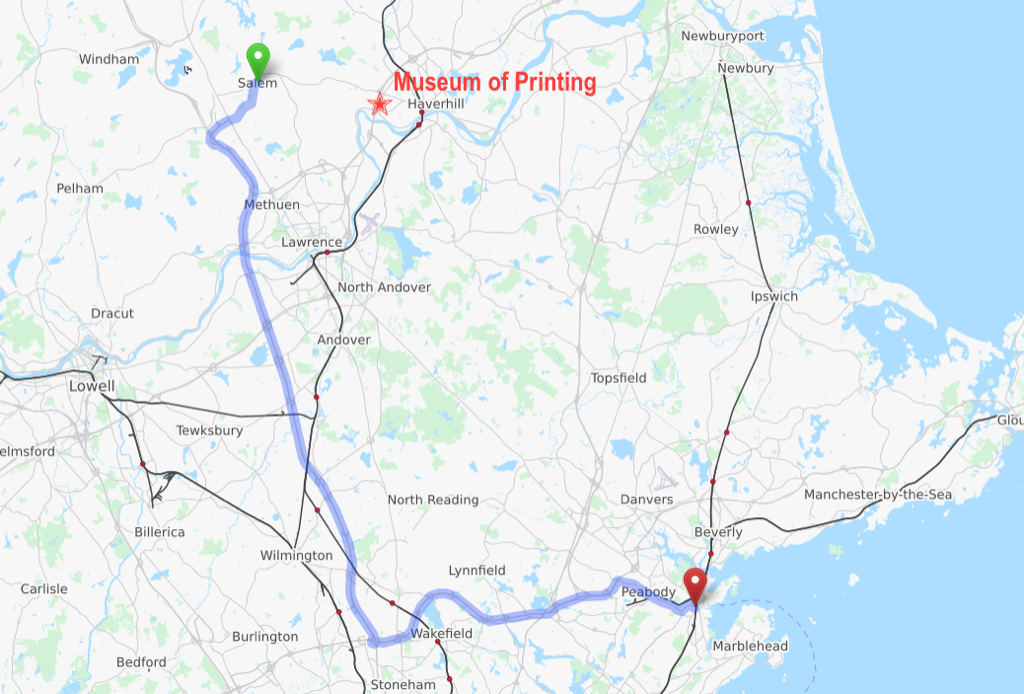
The error of my ways was twofold.
First, I reasoned, naively, that if the Museum of Printing was in Massachusetts, then I should–obviously–stay in Salem, Massachusetts.
Second, I paid no heed to ground truth, instead relying entirely on Google Maps to route me around. And thus developing no “lay of the land” that would have shown me immediately the error of my ways.
Fortunately, the only penalty for my foolishness was driving an extra hour up and and extra hour back. I enjoyed the Museum of Printing nonetheless. And maybe even a little more for the effort.
The museum, since my last visit in 2011, when it was located in North Andover, has relocated to a smart new location in Haverhill.
The book sale was, as it turned out, poorly attended, and for most of my visit I had the room to myself:
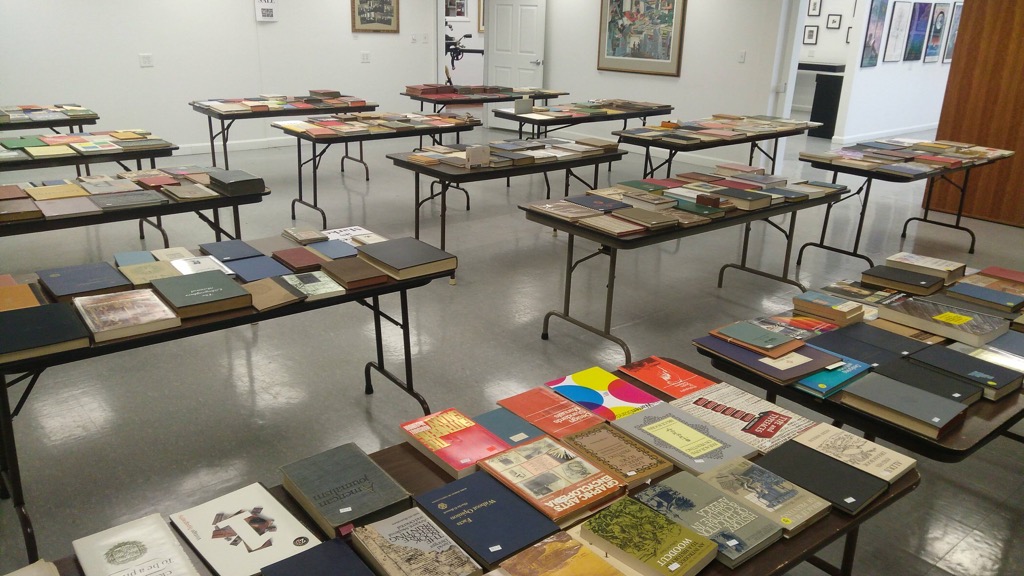
The books on offer ranged from type catalogues to biography to books that were simply examples of fine printing. There were an uncommon number of books about Benjamin Franklin, and almost as many books about Gutenberg, not surprising given the Boston birthplace of the former and the historic contributions of the later to the printing trade.
Another New Englander, at least for a time, was Frederic Goudy, type designer and printer, whose Village Press was, from 1904 to 1906, located in nearby Hingham, Massachusetts. Goudy is well-represented in the museum proper, with a collection of his books and papers, including this sketch of his personal monogram:
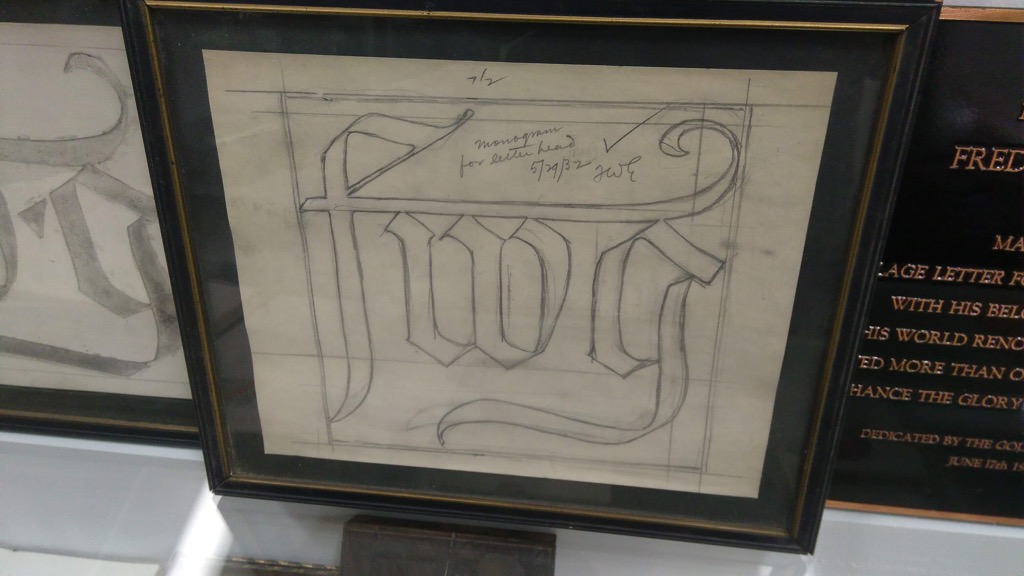
Goudy was also well-represented in the book sale and, as a longtime Goudy fanboy, this made me happy. And allowed me to return home with several Goudy-related items in my satchel.
The first was this book, Type Design, a 1961 edition produced by The Press of the Good Mountain at the Rochester Institute of Technology.

The book is derived from a Goudy essay in the 1934 Vol. 1, No. 4 of Ars Typographica, and while the cover is worn and ragged, inside is what might be not only the most beautiful book I own, but the most beautiful anything I own:
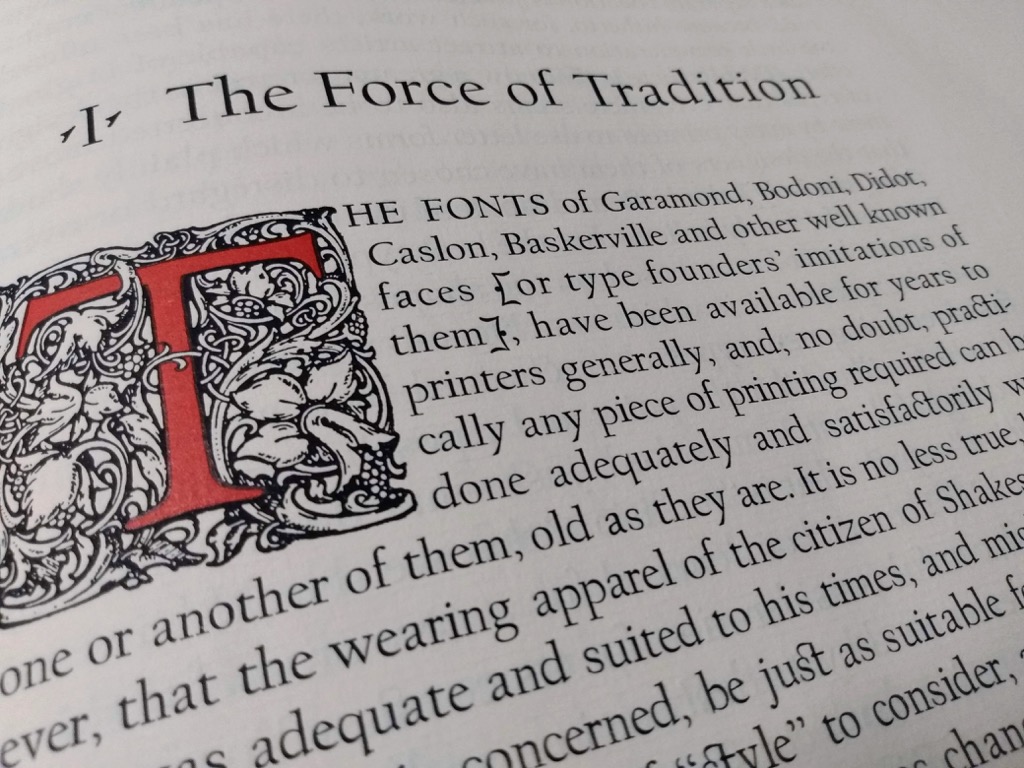
The book is set in Goudy’s Medieval and Californian typefaces and 100 were produced.
My next purchase was a book I appreciated initially because of this bookplate:

The idea that one would have a “Library of Books about Books” is delightful. When I purchased the book, The Dutch Claims to the Invention of Printing from 1928, I didn’t know anything about Frederic Melcher; he turns out to have been an estimable person who did, indeed, collect books about books:
A man who knew the insides of many books, he also cared about how a book is made, and encouraged graphic artists in the 20th century renaissance of American book design.
Mr. Melcher was a man who liked to put things in a historical perspective, and began collecting books about books almost as soon as he entered the business. More importantly, he encouraged young researchers and other scholars to use his collection in writing about book trade problems and history. He assembled noteworthy collections, too, in the fields of fine printing and children’s literature. As a personal publishing venture, he issued facsimile editions of several miniature books first published in Colonial America.
Much of Mr. Melcher’s accomplishment stemmed from a capacity to crystalize the essentials of an issue or an idea, and then, with infectious vigor, to impel groups of people to take action.
I only hope that some of that infectious vigor rides with the book.
The book is set in Nicolas Jenson, a face that, while no Californian, is lovely in its own way:
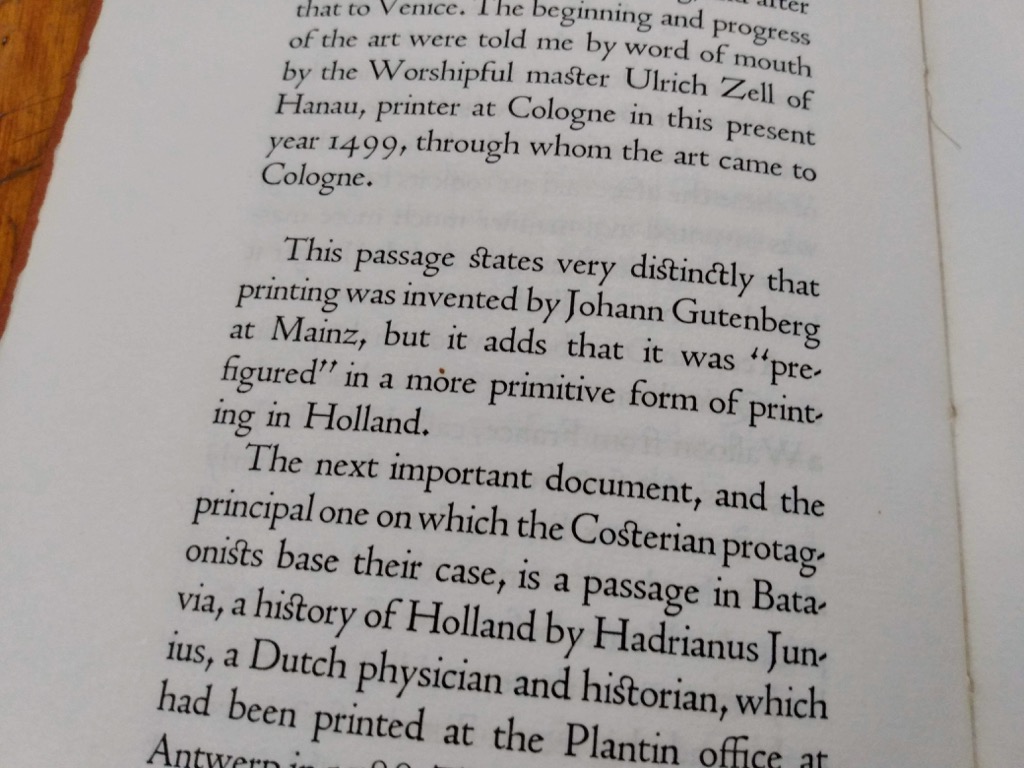
My final purchase from the book sale was a small book, priced at just $1, titled Fifteen Years of Bookbuilding, that jumped off the table at me for the craft that went into its creation.
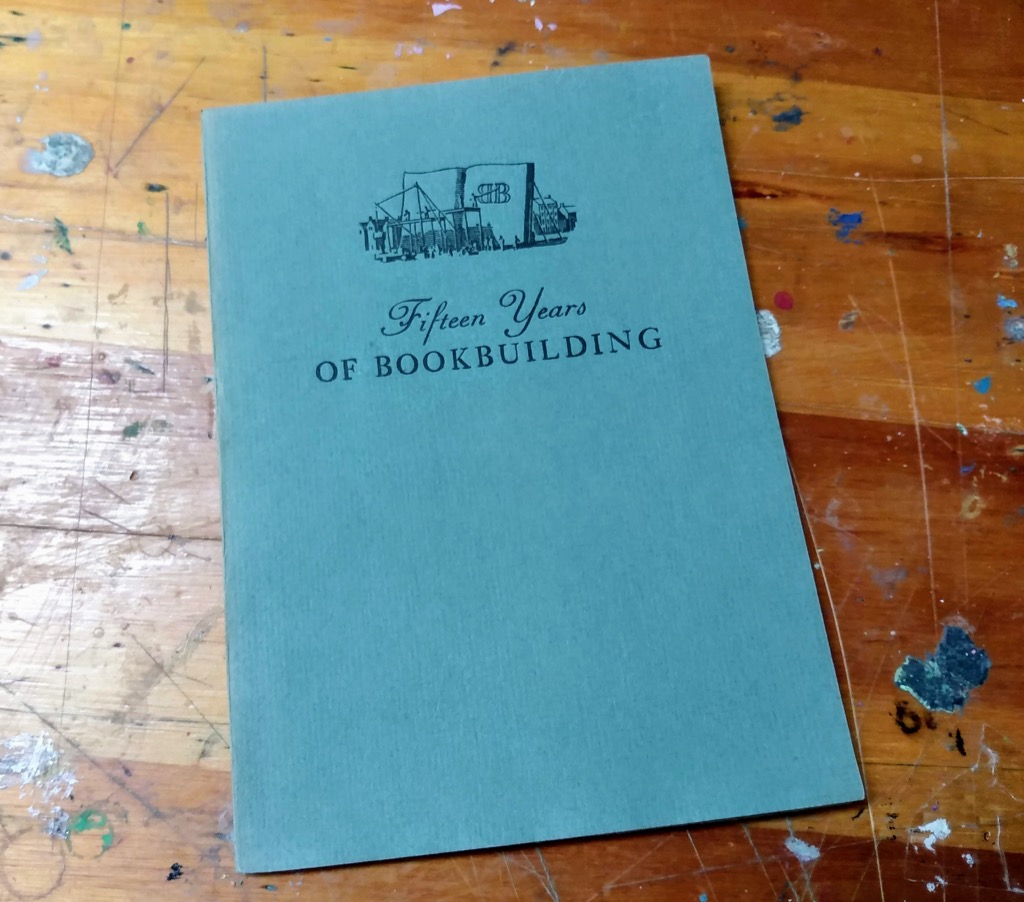
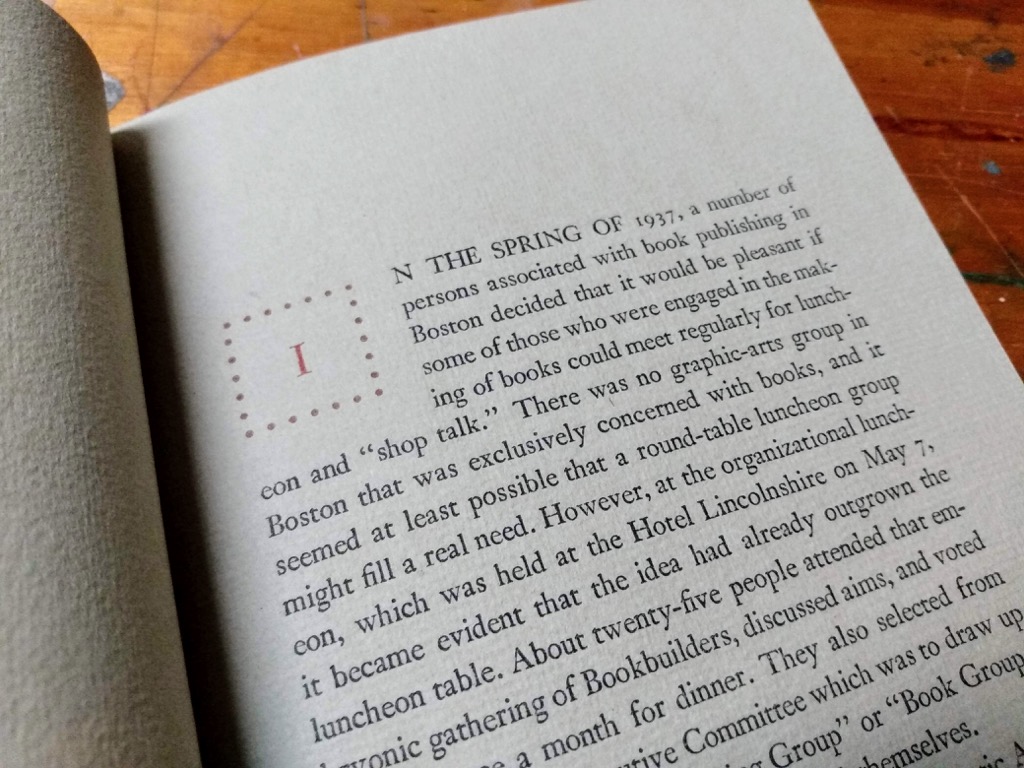
The book was produced in 1951 to mark the 15th anniversary of The Bookbuilders of Boston, an organization that, remarkably is still very much alive. The book was a group project, and is printed on very pleasant paper and is beautifully set in an uncredited typeface.
Once I’d spent 90 minutes in the book sale, I adjourned to tour the museum itself–an excellent overview of printing history, plus a printing workshop and a sizable library. I then finished my visit with a trip to the museum’s well-stocked shop.
My first purchase from the museum shop was this tiny, perfect font of type, on sale for just $16:
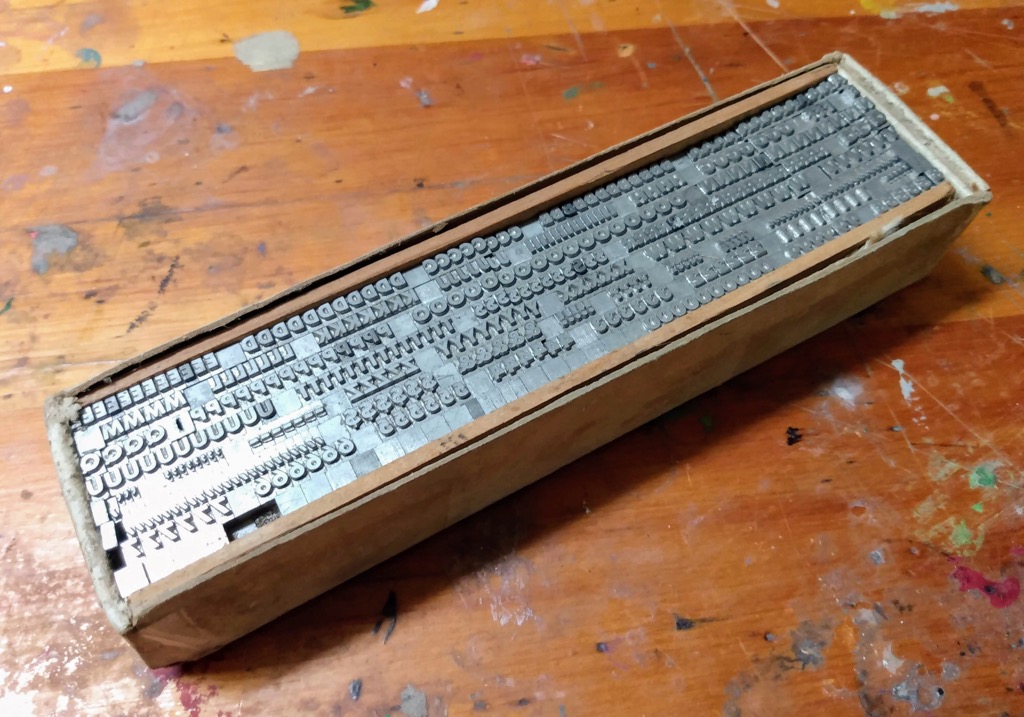
Purchasing this required that I bear the additional scrutiny that people carrying chunks of lead through airport security are subject to; as a result the package bore the branded tape of both the TSA and CASTA by the time I got home:

I’m happy to report that the agents from both agencies were careful and accommodating my requests to not spill the type, and it arrived home in good sorts.
In addition to the type, I found this letterpress cut from the Monadnock Region of New Hampshire, where I’d spent the week previous; it was only $5 and of course I purchased it:
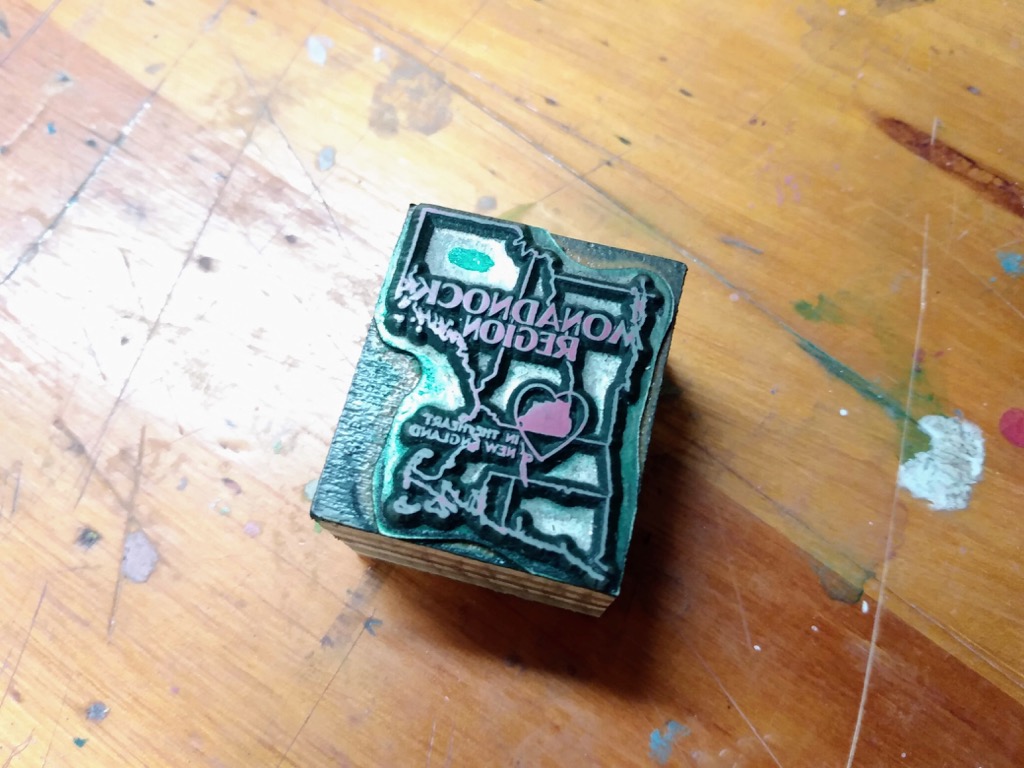
After two hours of shopping and browsing, I finished up my visit with a chat to the voluble and friendly volunteers at the front desk and bid farewell, happy that, despite having bunked in the wrong Salem, I’d found my way.
On the road from Dublin, NH to home, the slow way.
Tonight I’m in Salem, MA trying to effect a small birthday celebration for myself: fish tacos and beer, and a movie at what might be the world’s smallest cinema (and certainly is the once with the seating angled most weirdly). Just me and one other person watching Transit at 9:15 p.m.
I’m staying at the Merchant Salem, a “let me show you to your room and explain how to turn on the fireplace and the heated floor in the bathroom” hotel with just 10 rooms. An indulgence sponsored, unwittingly, by my parents and their generous birthday cheque.
Tomorrow I’m up to Beverly for a letterpress book sale, then to Boston for the night before heading home on Sunday morning.

In my spare evening hours here in New Hampshire this week I worked on a “Find your Green Candidate” widget for the Green Party campaign website.
This turned out not to be a trivial thing do to, in part because I couldn’t find a ready-made open data source of which civic addresses are in which electoral district. So I had take the electoral districts GIS layer and the civic address layer and use QGIS to run a point-in-polygon process to marry the two. The result was a MySQL table that looks like this:
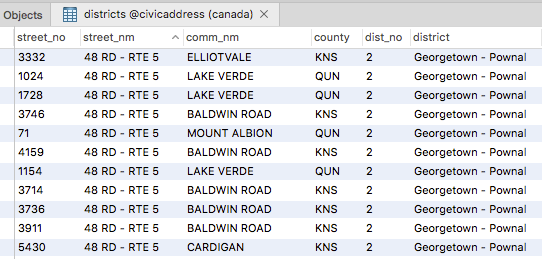
The table maps each civic address to its electoral district: like 71 48 RD is in District 2, for example.
Next I had to create a table of Green Party candidates, also keyed to electoral district:
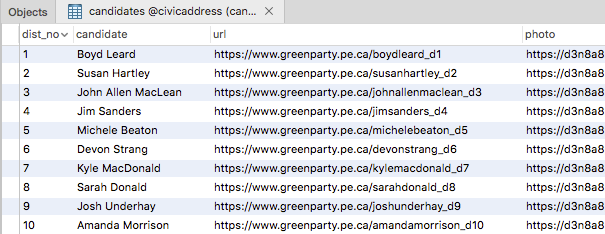
With this table I can look up who the Green candidate is for District 2, Susan Hartley.
With the data in place, I wrote an API, in PHP, that accepts a civic address fragment and returns matching addresses as an HTML fragment. For example, if I POST 99 B to this API, I get back:
<ul id="addresslist">
<li class="oneaddress" id="23|Tyne Valley - Sherbrooke|Trish Altass|https://www.greenparty.pe.ca/trishaltass_d23|https://d3n8a8pro7vhmx.cloudfront.net/greenpartype/pages/2026/attachments/original/1554002031/smaller_trish_altass.png?1554002031|99 BAGLOLE WHARF RD">99 BAGLOLE WHARF RD, SOUTHWEST LOT 16</li>
<li class="oneaddress" id="21|Summerside - Wilmot|Lynne Lund|https://www.greenparty.pe.ca/lynnelund_d21|https://d3n8a8pro7vhmx.cloudfront.net/greenpartype/pages/2026/attachments/original/1554002024/smaller_lynne_lund.png?1554002024|99 BALCOM DR">99 BALCOM DR, SUMMERSIDE</li>
<li class="oneaddress" id="8|Stanhope - Marshfield|Sarah Donald|https://www.greenparty.pe.ca/sarahdonald_d8|https://d3n8a8pro7vhmx.cloudfront.net/greenpartype/pages/2026/attachments/original/1554350635/smaller_sarah_donald.png?1554350635|99 BALD EAGLE LN">99 BALD EAGLE LN, MILLCOVE</li>
<li class="oneaddress" id="11|Charlottetown - Belvedere|Hannah Bell|https://www.greenparty.pe.ca/hannahbell_d11|https://d3n8a8pro7vhmx.cloudfront.net/greenpartype/pages/2026/attachments/original/1554002022/smaller_hannah_bell.png?1554002022|99 BARBOUR CIR">99 BARBOUR CIR, CHARLOTTETOWN</li>
</ul>
In other words, the first four addresses that match that address. If I send a longer address fragment to the API, like 99 BAL, I get the subset of addresses that continue to match:
<ul id="addresslist">
<li class="oneaddress" id="21|Summerside - Wilmot|Lynne Lund|https://www.greenparty.pe.ca/lynnelund_d21|https://d3n8a8pro7vhmx.cloudfront.net/greenpartype/pages/2026/attachments/original/1554002024/smaller_lynne_lund.png?1554002024|99 BALCOM DR">99 BALCOM DR, SUMMERSIDE</li>
<li class="oneaddress" id="8|Stanhope - Marshfield|Sarah Donald|https://www.greenparty.pe.ca/sarahdonald_d8|https://d3n8a8pro7vhmx.cloudfront.net/greenpartype/pages/2026/attachments/original/1554350635/smaller_sarah_donald.png?1554350635|99 BALD EAGLE LN">99 BALD EAGLE LN, MILLCOVE</li>
</ul>
You’ll notice that the ID of the list items returns contains all the data I need to render the candidate information for any address; while this isn’t efficient in terms of the size of the API payload, it does mean that I don’t need to make a second API call to get candidate details.
With the API in place, I wrote a JavaScript app to manage the actual candidate lookup.
The nice thing about this approach is that it’s a standalone tool that can be used in the field to help electors find their Green Candidate (it’s installable as a progressive web app) and it’s also embeddable in any other website:
That’s how you see on the Green Party candidates page, and how you can put it on your own website by pasting in:
<iframe scrolling="no" src="https://c.ruk.ca/election/index.html" style="width: 100%; height: 250px; border:0; margin-bottom: 20px; overflow: hidden"></iframe>
Since first releasing this a few days ago, I’ve been tweaking the design so that it integrates well with the Green website, and so that it behaves well inside an iframe on both desktop and mobile. It’s been a fun exercise.
I welcome any feedback you might have on how it works (or, if it doesn’t, how it’s broken!).
In my mid-twenties I was lucky enough to find myself immersed in a midwifery milieu, party to daily conversations about umbilical cords and breast latching and hospital transport. It was as good an introduction to the mechanics of birth as I can imagine one can get, and it served me well during Oliver’s adventurous one.
From my midwife friends, I learned about how we are born.
Now, thirty years later and with my compañera in palliative care, I’m learning a lot about how we die (or, fortunately and happily right now, how she doesn’t).
After an unexpected stay in hospital in the summer of 2016, Catherine enrolled in Prince Edward Island’s Palliative Home Care Program.
To that point in my life “palliative care” was, in my mind, a euphemism for “will be dead by Wednesday.”
“She’s gone to the palliative care,” someone would say, in hushed tones; and everyone in the room would take a short breath in, and nod in sad agreement.
I was happy to learn that this is not what palliative care is at all: three years later, Catherine is very much alive, and the palliative care program has been a tremendously positive help to her and to me and Oliver.
This passage, from Advice for Future Corpses (and Those Who Love Them), is a succinct explanation of what palliative care is and isn’t:
Palliative care is the specialty focused on comfort and quality of life in people with chronic and terminal illness, even while you seek a cure, even if you have come to terms with dying. (The cartoonist Roz Chast proposes “extreme palliative care,” which she thinks could include all-you-can-eat ice cream parlors and heroin.) I wear my bias on my sleeve. I believe in palliative care for anyone with a serious illness, and I know that palliative care can provide the support needed for a good death. Yet palliative care receives a laughably tiny fraction of the money spent on medical care.
One of the good physicians with whom I work keeps a cartoon on her office door. The doctor is talking to the patient, gowned and barefoot, sitting on the exam table: “You’ve got six months. But with aggressive treatment, we can help make that seem much longer.” No system is perfect, but a good palliative care program can make an enormous difference in a person’s life and death. The care given is interdisciplinary, which means that alongside the doctor and nurse may be social workers, chaplains, and physical, occupational, and speech therapists. Palliative care is concerned with everything that affects the quality of a person’s life, which might include treating the headache and going to the emergency room with a sprained ankle. This is all offered while you cope with cancer or heart disease or whatever brought you there. It may include help with bathing, visits to the eye doctor and the dentist, equipment like hearing aids and orthopedic shoes and walkers, recreational and respite programs, and visits to specialists.
Palliative care has a broad scope. Programs can be specific—for people in treatment for cancer—or general, for anyone with a chronic illness. A person in liver failure may benefit greatly from it while waiting for the transplant that will cure the liver failure. Cancer patients getting chemotherapy do better in treatment with palliative care because the team can help with symptoms. A program may offer acupuncture, help solve financial issues, sort out family dynamics, and design an exercise program—all while the person is trying to get better. My immense textbook calls this “active total care.” You can have palliative care while you’re trying to live, and you can have palliative care until the last hour of your life.
Our experience of Prince Edward Island’s program has been almost universally positive, and the integrated network of nurses and paramedics and the services they offer Catherine have kept her out of hospital more than once, have provided her with advice and insight that she wouldn’t otherwise have, and have reduced the cost of her medications. It’s a remarkable program that we feel blessed is available.
Hertz’s “take any car you want” lottery served me well this time, presenting a shiny red Kia Soul front and centre as we entered the lot. It is a zippy car, pleasantly roomy, with friendly controls.
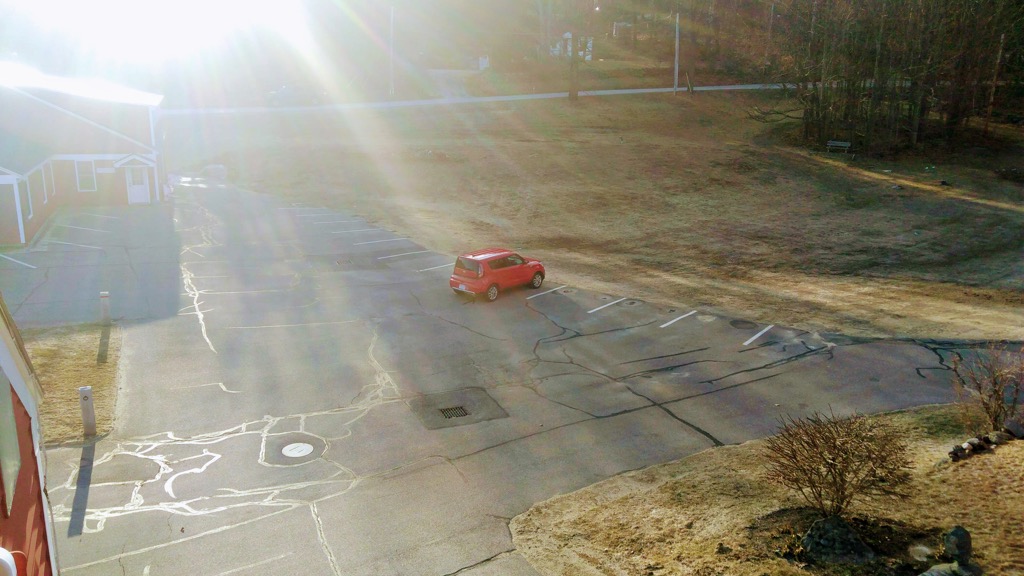
Tonight was a recapitulation of last night: I was back at Pearl for supper, this time with a different crew, all women, all Almanac-affiliated. A delightful bunch. I had oysters again (all Malpeques this time). And chili-grilled salmon again. Same play; different cast.
Earlier in the day I managed to almost miss the lunchtime vision board exercise at HQ, arriving only in the final minutes. So I didn’t have a lot of time to execute.
But I conjured some good vision; especially about the shirts and the yellow steering wheel.
And this despite my source material being limited to the AAA travel magazine and an issue of Country Woman.
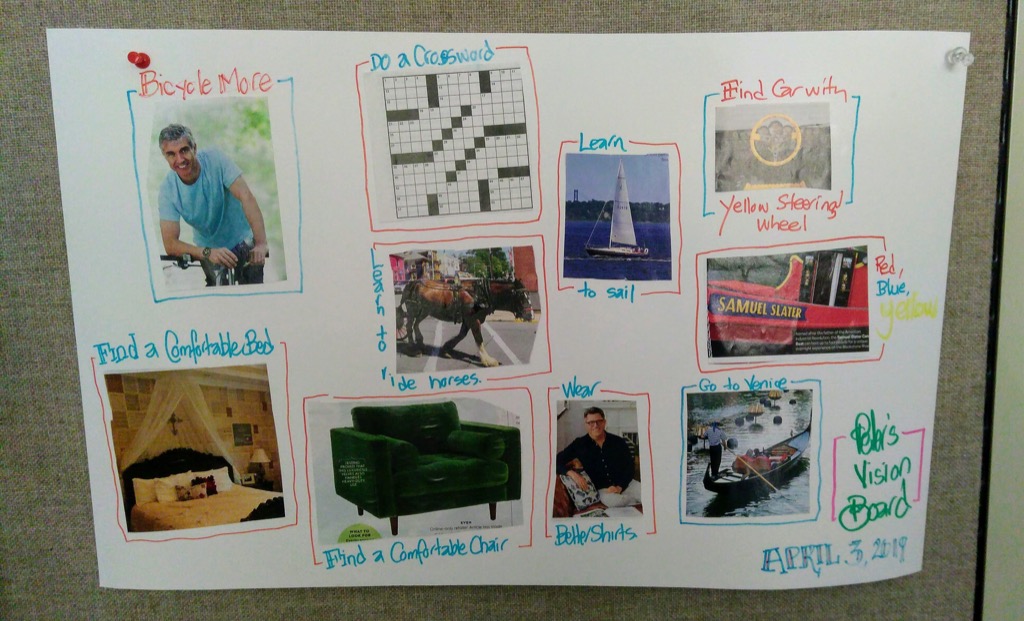
Oliver has volunteered for three days in a row at provincial Green Party headquarters at the campaign button-making machine.
He is a dynamo.
If your coat sports a button supporting a Green Party candidate this election, there’s a good change it was crafted for you by him.
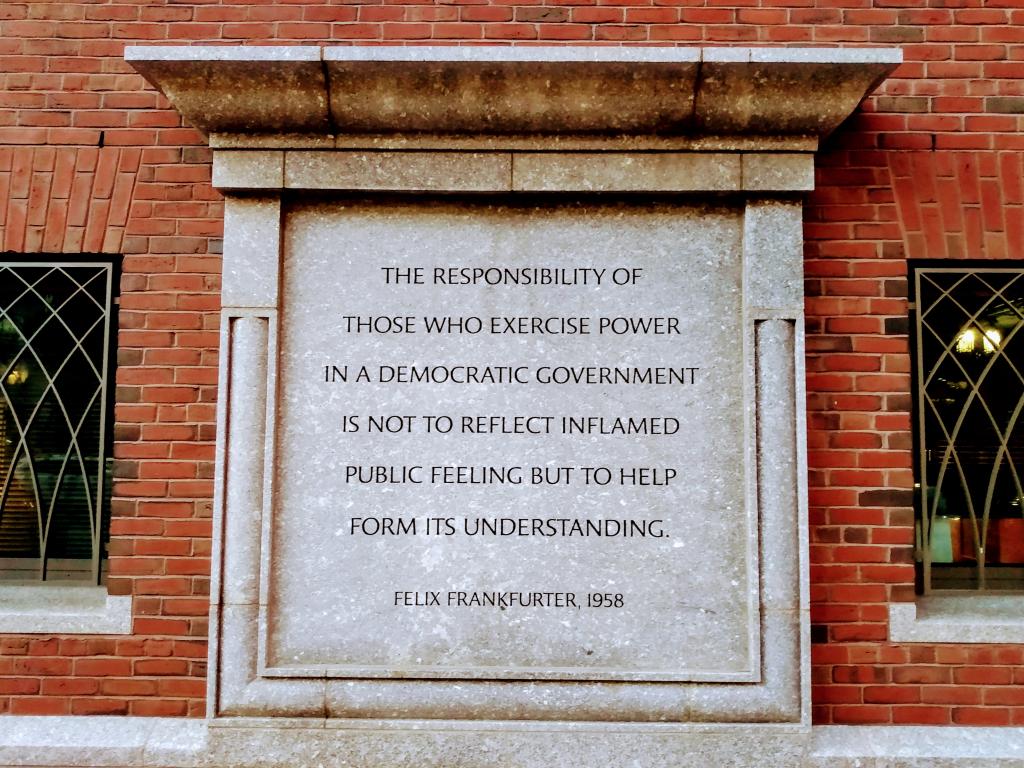
 I am
I am